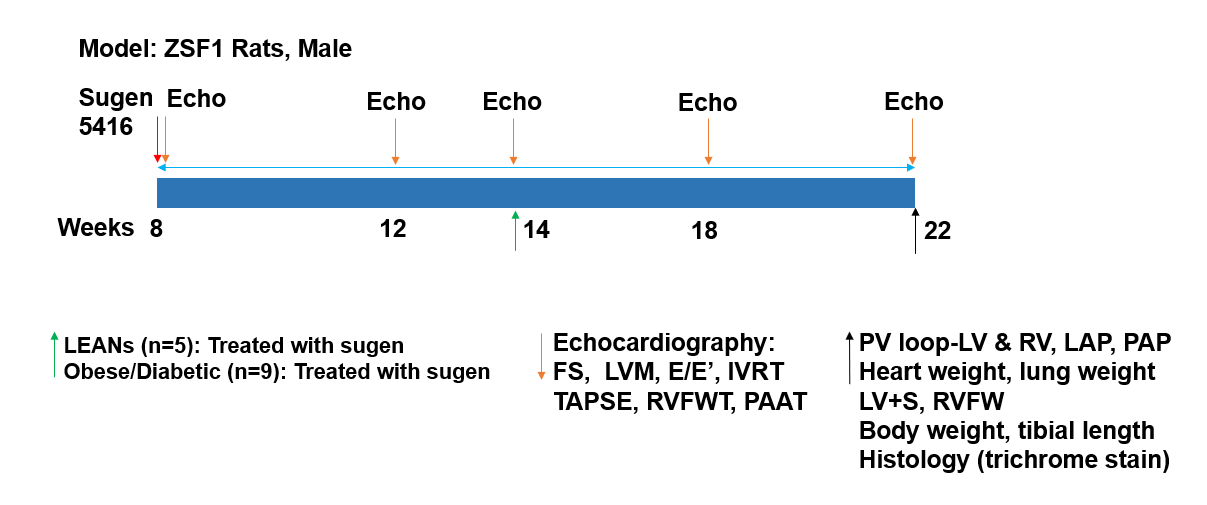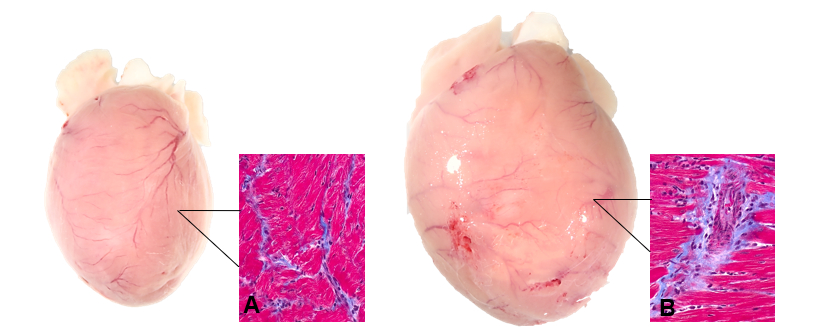Diabetic Cardiomyopathy Model
Diabetic cardiomyopathy is generally characterized by adverse cardiac remodeling, a complication from poorly regulated diabetes. Frequently, there are findings of hypertrophy, fibrosis, and reduced diastolic function.
Experimental Protocol

ZSF1 Rats treated with sugen are monitored for cardiac remodeling at specific timepoints during the study. A non-invasive echocardiogram is performed at 8 (baseline), 14, and 22 (final) weeks. A live pressure- volume loop is obtained at 22 weeks followed by final measurements, sample collection, and histology.
Histology

Figure 1. Cardiac hypertrophy and left-ventricular fibrosis in the (A) Lean and (B) Diabetic rats.
Table 1. Echocardiogram parameters at 8 weeks, 14 weeks, and 22 weeks in lean and diabetic rats.

Abbreviations: IVSd, Interventricular Septum Thickness at end Diastole; LVEDd, Left-Ventricular End-Diastolic Dimension; LVPTd, Left-Ventricle Posterior Wall Thickness Diastole; IVSs, Interventricular Septum Thickness at end Systole; LVESd, Left-Ventricular End-Systolic Dimension; LVPTs, Left-Ventricle Posterior Wall Thickness Systole; HR, Heart Rate; FS, Fractional Shortening; EF, Ejection Fraction; LVM, Left Ventricular Mass; E/E’, Left Ventricular Diastolic Function; RVFWT, Right Ventricle Free Wall Thickness; TAPSE, Tricuspid Annular Plane Systolic Excursion; PAAT, Pulmonary Artery Acceleration Time; RVFAC, Right Ventricle Fractional Area Changes. All parameters are expressed as means ± the SD. The P value was calculated by comparing the final echo between the Lean and Diabetic rats.
Table 2. Pressure-volume parameters of the left ventricle (open chest) in lean and diabetic rats.

Abbreviations: SW, Stroke Work; CO, Cardiac Output; SV, Stroke Volume; Vmax, Maximum Volume; Vmin, Minimum Volume; Pmax, Maximum Pressure; Pmin, Minimum Pressure; HR, Heart Rate; EF, Ejection Fraction; Ea, Arterial Elastance; dP/dt max, maximum derivative of change in systolic pressure over time; dP/dt min, minimum derivative of change in diastolic pressure over time; Tau, Left Ventricle Relaxation Constant; ESPVR, End-Systolic Pressure-Volume Relationship; EDPVR, End-Diastolic Pressure-Volume Relationship.
Sample Data

Figure 2. Glucose tolerance test in LEANs and Diabetic rats.
Diabetic cardiomyopathy is generally characterized by adverse cardiac remodeling, a complication from poorly regulated diabetes. Frequently, there are findings of hypertrophy, fibrosis, and reduced diastolic function.
Diabetic cardiomyopathy increases the risk of heart failure in people with diabetes. To develop effective treatment for heart failure, the Diabetic Cardiomyopathy Model allows us to better understand the pathophysiological mechanisms underlying the long-term complications of diabetes.
Transthoracic echocardiography allows for real-time analysis of cardiac remodeling throughout the study. Parasternal short axis (PSAX) view in B-Mode is most useful for visualizing the left ventricle structure and function. Using pulsed wave (PWD) and tissue Doppler (TDI), we are able to characterize left ventricle diastolic function.
Left ventricle catheterization to obtain live pressure-volume loop is performed terminally. It is extremely useful for acquiring accurate hemodynamic measurements.
Evidence of cardiac remodeling in the diabetic cardiomyopathy model model is supported using histology. Harvested organs with Masson’s trichrome staining help to identify regions and amount of fibrosis, indicated in blue.




